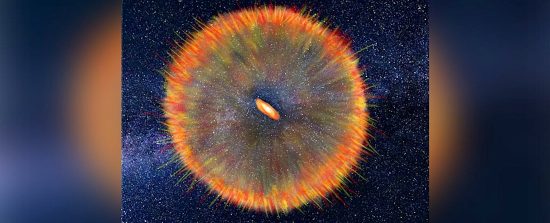
January 27, 2020
Do stars accrete?
The Nebular Hypothesis is the common star-forming theory. It is thought that stars condense out of primordial stuff, and that the remaining dust and gas that is not absorbed attracts more material, until it also condenses, but into planets. This is the consensus view about how the Solar System was created billions of years ago. Debris surrounding a new star is called an “accretion disk”.
According to a recent press release, sometimes a proto-star will exhibit a sudden increase in luminosity. Called an “accretion burst event”, it is when something they call “funnelling” draws excess matter down into the developing star structure. Like a whirlpool in space, astronomers believe that gravity accretes dusty gas into the center of a compression zone.
Star-forming regions are conventionally associated with high frequency light. Gamma rays, X-rays, and extreme ultraviolet shine from “cosmic eggs”, whose tips look like glowing gas balls. One example of these formations is in the Eagle Nebula, although the vast majority are located in the Orion Molecular Cloud and the Carina Nebula.
There is a basic flaw in reasoning when it comes to star formation and evolution. Electric Universe advocates think that stellar disks are not due to gravitational accretion, they are due to electromagnetic expulsion. Dust and gas should be found around stars. Stars “give birth” from their electrically charged interiors. There is no intensely hot core, radiating energy from thousands of kilometers deep inside. Instead, heavy elements are synthesized externally though plasma discharges and then “precipitate” into a star’s interior like a rain of metal atoms.
Many stars display transverse, donut-shaped twisted rings. Birkeland currents confine plasma within electromagnetic fields, causing toroidal concentrations. Toroidal filaments couple to hourglass-shaped current sheets that are subject to diocotron instabilities: the current flow through plasma sometimes forms vortices that change into distorted curlicue shapes. This phenomenon has been witnessed in many laboratory experiments.
In an Electric Universe, the electromagnetic field of a star is what drives all activity. Incoming electric charge is focused by Bennett pinches into highly energetic plasmoids. More incoming electric current means more stellar output, especially at higher wavelengths. The reason some rings flatten and curl at the edges is because of plasma instabilities in the torus. “As electric current density increases the edges curl in and out and upwards and downwards to the current flow.” (Anthony L. Peratt, Characteristics for the Occurrence of a High-Current, Z-Pinch Aurora as Recorded in Antiquity).
Electric Star theory resolves many of the distorted opinions that arise from misunderstanding the role of plasma and electric fields in space. Rather than kinetic activity, radiant emanations are primarily due to electric currents.
Stephen Smith
The Thunderbolts Picture of the Day is generously supported by the Mainwaring Archive Foundation.












